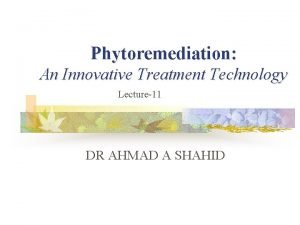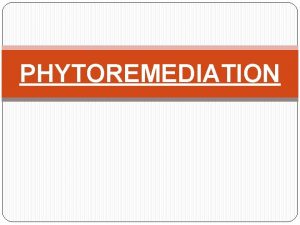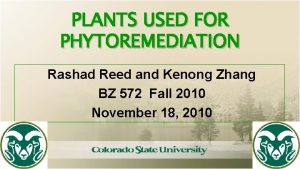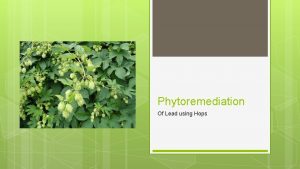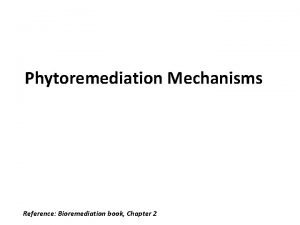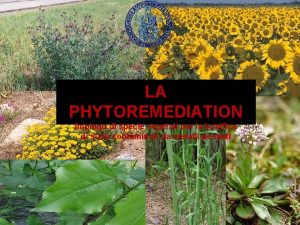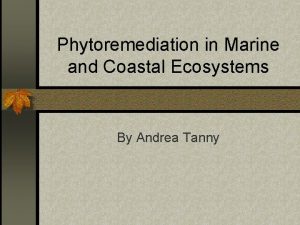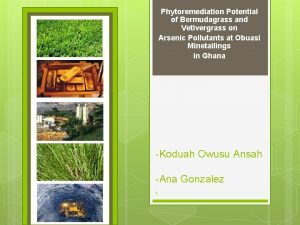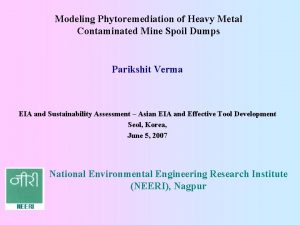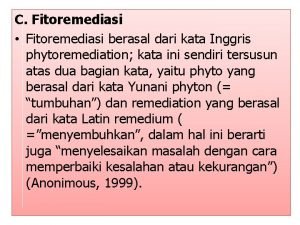Phytoremediation 1 What is Phytoremediation Phytoremediation The process

















- Slides: 17

Phytoremediation 1

What is Phytoremediation? • Phytoremediation : The process of removing contamination from soil or water using plants. • phyto = plant • remedium = restoring balance. 2

3

Phytoremediation consists of mitigating pollutant in concentrations contaminated soils, water, or air, with plants 4

5

Advantages of plants: Phytoremediation is cost effective. It is suited to remediation of large areas of soil. It is environmentally friendly. Phytoremediation sites are more aesthetically pleasing Phytoremediation sites are low maintenance. It involves no noisy and expensive equipment 6

Disadvantages Phytoremediation is limited to sites with lower contaminant concentrations. Toremediation is restricted to sites with contamination as deep as the roots of the plants being used. Not as effective for sites with high contaminant concentrations Phytoremediation is slower than conventional methods It does not work through the winter (Seasonally effective) The food chain could be adversely affected by the degradation of chemicals. The air could be contaminated by the burning of leaves or limbs of plants containing dangerous chemicals. 7

Phytoremediation The most important phytoremediation? 6 CO 2 + 6 H 2 O single act of C 6 H 12 O 6 + 6 O 2 8

How Does Phytoremediation Work? Plant roots take contaminants from the ground into the "body" of the plant. The plant root zone is referred to as the rhizosphere, this is where the action occurs. This soil supports large populations of diverse microorganisms. This is due to chemicals exuded by plant roots which provide carbon and energy for microbial growth. This combination of plants and microorganisms appears to increase the biodegradation of compounds. 9

This graphic shows a typical process diagram of phytoremediation. 10

Heavy metals • Arsenic Cadmium Lead Aluminum Beryllium Copper Iron Mercury Nickel These persist in soils and are toxic to animals even in small quantities

Various phytoremdiation processes 1. Phytoextraction or phytoconcentration, where the contaminant is concentrated in the roots, stem and foliage of the plant, 2. Phytodegradation, where plant enzymes help catalyze breakdown of the contaminantmolecule, 3. Rhizosphere biodegradation, where plant roots release nutrients to microorganisms which are active in biodegradation of the contaminant molecule, 4. Volatilization, where transpiration of organics, selenium and mercury run through leaves of the plant, 5. Stabilization, where the plant converts the contaminant into a form which is not bioavailable, or the plant prevents the spreading of a contaminant plume.


phytoremdiation Plants used to decontaminate soils must do one or more of the following: • Take up contaminants from soil particles and/or soil liquid into their roots, • Bind the contaminant into their root tissue, physically and/or chemically, • Transport the contaminant from their roots into growing shoots, • Prevent or inhibit the contaminant from leaching out of the soil. 14

Types of Vegetation Used Some of the plants used in phytoremediation are: • Alfalfa • Hybrid Poplar Trees • Blue-green Algae • Arrowroot • Sudan Grass • Rye Grass • Duck Weed • Bermuda Grass • Alpine Bluegrass • Yellow or White Water Lillies 15

16

17
 Types of phytoremediation
Types of phytoremediation Bamboo phytoremediation
Bamboo phytoremediation Rhizofiltration definition
Rhizofiltration definition Rashad plant
Rashad plant Lead phytoremediation
Lead phytoremediation Hát kết hợp bộ gõ cơ thể
Hát kết hợp bộ gõ cơ thể Slidetodoc
Slidetodoc Bổ thể
Bổ thể Tỉ lệ cơ thể trẻ em
Tỉ lệ cơ thể trẻ em Gấu đi như thế nào
Gấu đi như thế nào Thang điểm glasgow
Thang điểm glasgow Chúa yêu trần thế
Chúa yêu trần thế Môn thể thao bắt đầu bằng chữ f
Môn thể thao bắt đầu bằng chữ f Thế nào là hệ số cao nhất
Thế nào là hệ số cao nhất Các châu lục và đại dương trên thế giới
Các châu lục và đại dương trên thế giới Công thức tính độ biến thiên đông lượng
Công thức tính độ biến thiên đông lượng Trời xanh đây là của chúng ta thể thơ
Trời xanh đây là của chúng ta thể thơ Cách giải mật thư tọa độ
Cách giải mật thư tọa độ
